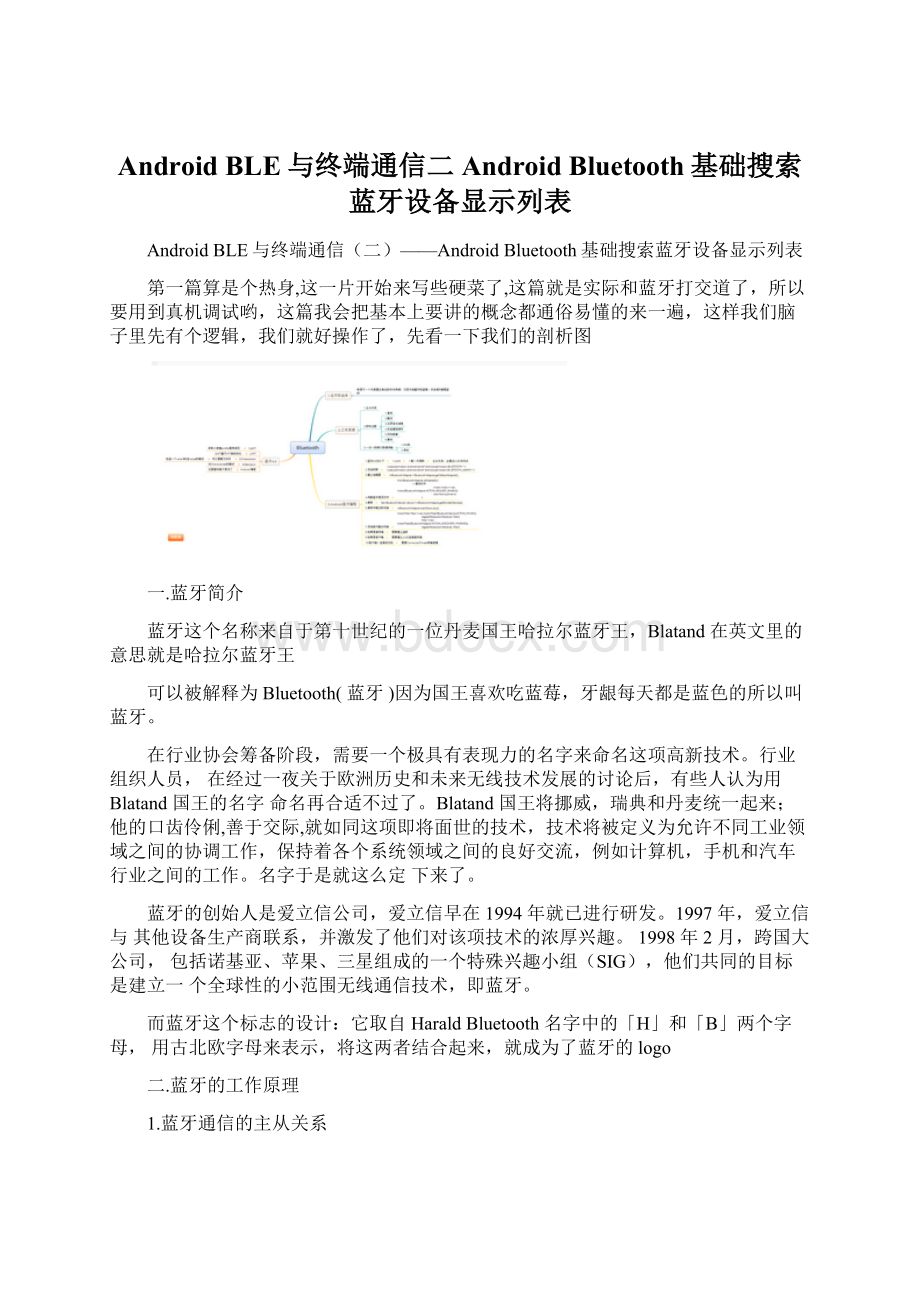Android BLE与终端通信二Android Bluetooth基础搜索蓝牙设备显示列表Word文档下载推荐.docx
《Android BLE与终端通信二Android Bluetooth基础搜索蓝牙设备显示列表Word文档下载推荐.docx》由会员分享,可在线阅读,更多相关《Android BLE与终端通信二Android Bluetooth基础搜索蓝牙设备显示列表Word文档下载推荐.docx(12页珍藏版)》请在冰豆网上搜索。

一个具备蓝牙通讯功能的设备,可以在两个角色间切换,平时工作在从模式,等待其它主设备来连接,需要时,转换为主模式,向其它设备发起呼叫。
一个蓝牙设备以主模式发起呼叫时,需要知道对方的蓝牙地址,配对密码等信息,配对完成后,可直接发起呼叫。
2.蓝牙的呼叫过程
蓝牙主端设备发起呼叫,首先是查找,找出周围处于可被查找的蓝牙设备。
主端设备找到从端蓝牙设备后,与从端蓝牙设备进行配对,此时需要输入从端设备的PIN码,也有设备不需要输入PIN码。
配对完成后,从端蓝牙设备会记录主端设备的信任信息,此时主端即可向从端设备发起呼叫,已配对的设备在下次呼叫时,不再需要重新配对。
已配对的设备,做为从端的蓝牙耳机也可以发起建链请求,但做数据通讯的蓝牙模块一般不发起呼叫。
链路建立成功后,主从两端之间即可进行双向的数据或语音通讯。
在通信状态下,主端和从端设备都可以发起断链,断开蓝牙链路。
3.蓝牙一对一的串口数据传输应用
蓝牙数据传输应用中,一对一串口数据通讯是最常见的应用之一,蓝牙设备在出厂前即提前设好两个蓝牙设备之间的配对信息,主端预存有从端设备的PIN码、地址等,两端设备加电即自动建链,透明串口传输,无需外围电路干预。
一对一应用中从端设备可以设为两种类型,一是静默状态,即只能与指定的主端通信,不被别的蓝牙设备查找;
二是开发状态,既可被指定主端查找,也可以被别的蓝牙设备查找建链。
三.蓝牙Android编程应用
1.相关部署
AndroidBLE与终端通信
(一)——AndroidBluetooth基础API以及简单使用获取本地蓝牙名称地址
下面依然会被提及
2.UUID
1.1认识一下UUIDUUID含义是通用唯一识别码(UniversallyUniqueIdentifier),这是一个软件建构的标准,也是被开源软件基金会(OpenSoftwareFoundation,OSF)的组织应用在分布式计算环境(DistributedComputingEnvironment,DCE)领域的一部分。
在蓝牙3.0及一下版本中,UUID被用于唯一标识一个服务,比如文件传输服务,串口服务、打印机服务等,如下:
蓝牙串口服务
SerialPortServiceClass_UUID=‘{00001101-0000-1000-8000-00805F9B34FB}’
LANAccessUsingPPPServiceClass_UUID=‘{00001102-0000-1000-8000-00805F9B34FB}’
拨号网络服务
DialupNetworkingServiceClass_UUID=‘{00001103-0000-1000-8000-00805F9B34FB}’
信息同步服务
IrMCSyncServiceClass_UUID=‘{00001104-0000-1000-8000-00805F9B34FB}’SDP_OBEXObjectPushServiceClass_UUID=‘{00001105-0000-1000-8000-00805F9B34FB}’
文件传输服务
OBEXFileTransferServiceClass_UUID=‘{00001106-0000-1000-8000-00805F9B34FB}’IrMCSyncCommandServiceClass_UUID=‘{00001107-0000-1000-8000-00805F9B34FB}’
蓝牙的连接有主从设备,提供服务的可以认为是从设备。
主设备通过UUID访问从设备提供具有相同UUID的服务,从而建立客服端—服务器(C/S)模式。
四.实际应用
我们新建一个Eclipse工程:
BluetoothGet
1.蓝牙协议
我们直接看图(简单的概念)
2.蓝牙权限
<
uses-permissionandroid:
name="
android.permission.BLUETOOTH"
/>
android.permission.BLUETOOTH_ADMIN"
3.编写程序
activity_main.xml
布局很简单,就一个搜索按钮和一个textview的列表
LinearLayoutxmlns:
android="
xmlns:
tools="
android:
layout_width="
match_parent"
layout_height="
orientation="
vertical"
>
<
Button
id="
@+id/btnSearch"
wrap_content"
text="
搜索蓝牙设备"
/>
TextView
@+id/tvDevices"
/LinearLayout>
步骤分析
1.首先获取本地的蓝牙适配器
//获取本地蓝牙适配器
mBluetoothAdapter=BluetoothAdapter.getDefaultAdapter();
2.判断手机是否支持蓝牙
//判断手机是否支持蓝牙
if(mBluetoothAdapter==null){
Toast.makeText(this,"
设备不支持蓝牙"
Toast.LENGTH_SHORT).show();
finish();
}
3.判断蓝牙是否打开
//判断是否打开蓝牙
if(!
mBluetoothAdapter.isEnabled()){
//弹出对话框提示用户是后打开
Intentintent=newIntent(BluetoothAdapter.ACTION_REQUEST_ENABLE);
startActivityForResult(intent,1);
//不做提示,强行打开
//mBluetoothAdapter.enable();
4.获取已经配对的设备
//获取已经配对的设备
Set<
BluetoothDevice>
pairedDevices=mBluetoothAdapter.getBondedDevices();
//判断是否有配对过的设备
if(pairedDevices.size()>
0){
for(BluetoothDevicedevice:
pairedDevices){
//遍历到列表中
tvDevices.append(device.getName()+"
:
"
+device.getAddress());
Log.i("
已配对设备"
tvDevices.getText().toString());
5.搜索的点击事件
@Override
publicvoidonClick(Viewv){
switch(v.getId()){
caseR.id.btnSearch:
//设置进度条
setProgressBarIndeterminateVisibility(true);
setTitle("
正在搜索..."
);
//判断是否在搜索,如果在搜索,就取消搜索
if(mBluetoothAdapter.isDiscovering()){
mBluetoothAdapter.cancelDiscovery();
//开始搜索
mBluetoothAdapter.startDiscovery();
break;
6.搜索的广播
1.注册广播
/**
*异步搜索蓝牙设备——广播接收
*/
//找到设备的广播
IntentFilterfilter=newIntentFilter(BluetoothDevice.ACTION_FOUND);
//注册广播
registerReceiver(receiver,filter);
//搜索完成的广播
filter=newIntentFilter(BluetoothAdapter.ACTION_DISCOVERY_FINISHED);
1.广播接收器
//广播接收器
privatefinalBroadcastReceiverreceiver=newBroadcastReceiver(){
@Override
publicvoidonReceive(Contextcontext,Intentintent){
//收到的广播类型
Stringaction=intent.getAction();
//发现设备的广播
if(BluetoothDevice.ACTION_FOUND.equals(action)){
//从intent中获取设备
BluetoothDevicedevice=intent
.getParcelableExtra(BluetoothDevice.EXTRA_DEVICE);
//判断是否配对过
if(device.getBondState()!
=BluetoothDevice.BOND_BONDED){
//添加到列表
+device.getAddress()+"
\n"
//搜索完成
}elseif(BluetoothAdapter.ACTION_DISCOVERY_FINISHED
.equals(action)){
//关闭进度条
搜索完成!
};
好了,到此,我们的程序算是完成了
MainActivity
packagecom.lgl.bluetoothget;
importjava.util.Set;
importandroid.app.Activity;
importandroid.bluetooth.BluetoothAdapter;
importandroid.bluetooth.BluetoothDevice;
importandroid.content.BroadcastReceiver;
importandroid.content.Context;
importandroid.content.Intent;
importandroid.content.IntentFilter;
importandroid.os.Bundle;
importandroid.util.Log;
importandroid.view.View;
importandroid.view.View.OnClickListener;
importandroid.widget.Button;
importandroid.widget.TextView;
importandroid.widget.Toast;
publicclassMainActivityextendsActivityimplementsOnClickListener{
//本地蓝牙适配器
privateBluetoothAdaptermBluetoothAdapter;
//搜索到蓝牙添加
privateTextViewtvDevices;
//搜索蓝牙的按钮
privateButtonbtnSearch;
protectedvoidonCreate(BundlesavedInstanceState){
super.onCreate(savedInstanceState);
setContentView(R.layout.activity_main);
initView();
privatevoidinitView(){
tvDevices=(TextView)findViewById(R.id.tvDevices);
btnSearch=(Button)findViewById(R.id.btnSearch);
btnSearch.setOnCListener(this);
//获取本地蓝牙适配器
mBluetoothAdapter=BluetoothAdapter.getDefaultAdapter();
//判断手机是否支持蓝牙
//判断是否打开蓝牙
//获取已经配对的设备
pairedDevices=mBluetoothAdapter
.getBondedDevices();
//设置进度条
//广播接收器
//关闭进度条
}
我们运行一下